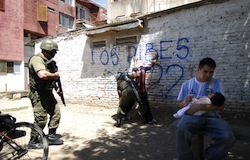A neighborhood in Buenos Aires has been caught in the crosshairs of a battle between Peruvian, Paraguayan, and Colombian drug gangs in an illustration of the impact a growing domestic drug market and criminal migration are having on Argentina.
On April 12, four Paraguayans were killed in Buenos Aires’ Bajo Flores neighborhood in an attack that authorities believe is part of an ongoing dispute for control of the local drug trade, reported El Pais.
Argentine officials suspect the attack may be linked to a battle between a Paraguayan gang and an Argentine group known as the Gauchito Gil gang, reported La Nacion. A February shootout between these two gangs resulted in the deaths of two innocent bystanders.
However, the Paraguayan publication ABC Color speculated that the deaths could also be the result of a decade-long conflict between Peruvian and Paraguayan gangs in Buenos Aires. Paraguayan groups have traditionally controlled the marijuana trade in the Bajo Flores neighborhood, while Peruvian groups have distributed cocaine and “paco” — a form of crack cocaine — but the criminal groups have come into conflict in recent years, ABC Color stated. Colombian gangs are also battling Peruvian groups for control of cocaine distribution in Buenos Aires, reported La Nacion.
InSight Crime Analysis
The bloodshed in Buenos Aires’ Bajo Flores neighborhood appears to be the result of a combination of two different dynamics: a growing domestic drug market and criminal migration from other Latin American countries.
In recent years, Argentina has seen rising drug consumption, which has in turn spurred the development of local criminal groups dedicated to micro-trafficking often accompanied by a spike in violence in some parts of the country.
Meanwhile, foreign criminal groups appear to be increasingly setting up shop in Argentina. While Paraguayan and Peruvian criminals have had a presence in Buenos Aires since at least the mid-1990s, and Colombian drug traffickers have long used the country as a hideout, the influx of foreign criminals appears to have intensified as Argentina’s importance as a drug transit nation has increased.
Coverage of Criminal Migration
An Argentine NGO recently reported that a Peruvian criminal network with ties to the Shining Path guerrilla group runs at least ten cocaine laboratories in the Bajo Flores neighborhood, claims that prompted Pope Francis to comment on the “Mexicanization” of Argentina.
As similar dynamics play out elsewhere in Latin America, other countries may start to see foreign criminals involved not only in transnational drug shipments, but also in micro-trafficking and other localized crimes. In Ecuador in 2011, for example, the leader of a Colombian criminal group known as La Cordillera was arrested for allegedly running a micro-trafficking network in Quito. In Bolivia, five “mega-gangs” made up of foreign criminals dedicated to armed robberies were identified in 2014, while eastern Paraguay has recently seen a wave of armed robberies allegedly carried out by Brazilian criminals.

